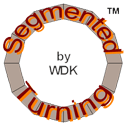 |
Segmented TurningDesign your first segmented project in 5 minutes with the Segmented Project Planner |
|||
|
| Products | Classes | Free Plans | Hints | Buy Now | Gallery | Wood Costs | User Projects | FAQ |
|
|
When you start gluing rings together into a project, the accuracy of your placement of each ring dictates how much wider each ring must be than required by the design. And, if you glue up the whole project in one step, the error at each layer is multiplied so that the error on the final layer can be significant. To minimize what I call the Glue Up Tolerance, glue the rings together one at a time and use the lathe to true up the last glued ring before proceeding to the next ring. If you don't use a planer or thickness sander to flatten your rings, you should also true up the face of each ring as you go. As a result of gluing only one layer at a time, my Glue Up Tolerance is a mere 1/16". If your project has a concave inner surface or has a relatively small diameter, you can get a benefit from putting the project on the lathe after gluing on each ring. You can rough out the inside as you go without the upper layers being in the way. Curt Theobald sells a simple jig you can use to center each ring on a developing project. It basically consists of a 45 degree cone mounted via a lathe arbor in the tailstock of your lathe. Although you'll have to make several sizes to cover all situations, just apply glue to the new ring, place it over the cone, and move the tailstock toward the project until contact is made. Then perform any rotational alignment necessary and crank in the tailstock to provide clamping pressure. Be sure to use a good hard wood for the cone so that the ring moves into the proper center rather than compressing the cone material. |
